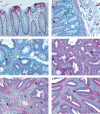Immunohistochemical assessment of mitochondrial superoxide dismutase (MnSOD) in colorectal premalignant and malignant lesions
- PMID: 28053678
- PMCID: PMC5209461
- DOI: 10.5114/pg.2016.57943
Immunohistochemical assessment of mitochondrial superoxide dismutase (MnSOD) in colorectal premalignant and malignant lesions
Abstract
Introduction: It is generally accepted that mitochondria are a primary source of intracellular reactive oxygen species (ROS). Under physiological circumstances they are permanently formed as by-products of aerobic metabolism in the mitochondria. To counter the harmful effect of ROS, cells possess an antioxidant defence system to detoxify ROS and avert them from accumulation at high concentrations. Mitochondria-located manganese superoxide dismutase (MnSOD, SOD2) successfully converts superoxide to the less reactive hydrogen peroxide (H2O2). To the best of our knowledge, there are no available data regarding immunohistochemical expression of MnSOD in colorectal neoplastic tissues.
Aim: To investigate the immunohistochemical expression status of MnSOD in colorectal premalignant and malignant lesions.
Material and methods: This study was performed on resected specimens obtained from 126 patients who had undergone surgical resection for primary sporadic colorectal cancer, and from 114 patients who had undergone colonoscopy at the Municipal Hospital in Jaworzno (Poland). Paraffin-embedded, 4-µm-thick tissue sections were stained for rabbit polyclonal anti SOD2 antibody obtained from GeneTex (clone TF9-10-H10 from America Diagnostica).
Results: Results of our study demonstrated that the development of colorectal cancer is connected with increased expression of MnSOD both in adenoma and adenocarcinoma stages. Samples of adenocarcinoma with G2 and G3 grade showed significantly higher levels of immunohistochemical expression of this antioxidant enzyme. Moreover, patients with the presence of lymphovascular invasion and higher degree of regional lymph node status have been also characterised by higher levels of MnSOD expression. The samples of adenoma have been characterised by higher levels of MnSOD expression in comparison to normal mucosa as well. Interestingly, there was no significant correlation between expression and histological type of adenoma.
Conclusions: Development of colorectal cancer is connected with increased expression of MnSOD both in adenoma and adenocarcinoma stages.
Keywords: colorectal adenoma; colorectal cancer; immunohistochemistry; manganese superoxide dismutase; oxidative stress.
Conflict of interest statement
The authors declare no conflict of interest.
Figures

References
-
- Kowaltowski AJ, Souza-Pinto NC, Castilho RF, Vercesi AE. Mitochondria and reactive oxygen species. Free Radic Biol Med. 2009;47:333–43. - PubMed
-
- Brand MD, Affourtit C, Esteves TC, et al. Mitochondrial superoxide: production, biological effects, and activation of uncoupling proteins. Free Radic Biol Med. 2004;37:755–67. - PubMed
-
- Pervaiz S, Clement MV. Superoxide anion: oncogenic reactive species? Int J Biochem Cell Biol. 2007;39:1297–304. - PubMed
LinkOut - more resources
Full Text Sources
Other Literature Sources
